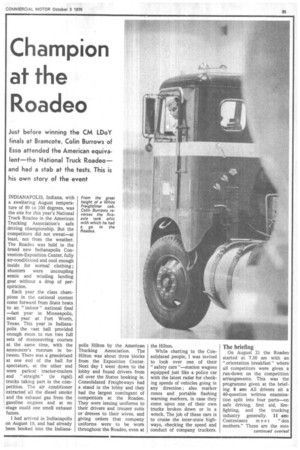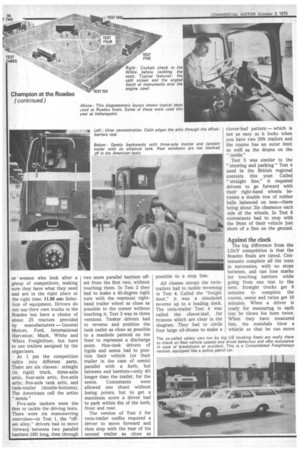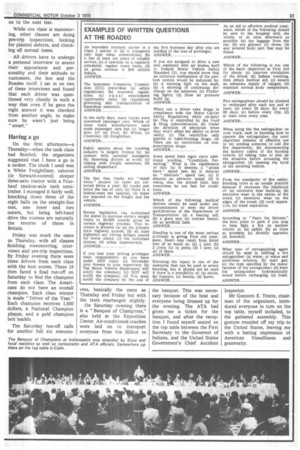Champion at the Roadeo
Page 37

Page 38

Page 39

If you've noticed an error in this article please click here to report it so we can fix it.
Just before winning the CM LDoY finals at Bramcote, Colin Burrows of Esso attended the American equivalent—the National Truck Roadeoand had a stab at the tests. This is his own story of the event
INDIANAPOLIS, Indiana, with a sweltering August temperature of 90 to 100 degrees, was the site for this year's National Truck Roadeo in the American Trucking Association's safe driving championship. But the competitors did not sweat—at least, not from the weather. The Roadeo was held in the brand new Indianapolis Convention-Exposition Center, fully air-conditioned and cool enough inside for normal clothing ; shunters were uncoupling semis and winding landing gear without a drop of perspiration.
Each year the class champions in the national contest come forward from State heats to an " indoor" national final —last year in Minneapolis, next year at Fort Worth, Texas. This year in Indianapolis the vast hall provided enough room to run two full sets of manoeuvring courses at the same time, with the announcer's rostrum in between. There was a grandstand at one end of the hall for spectators, at the other end were parked• tractor-trailers and "straight " (ie rigid) trucks taking part in the competition. The air conditioner extracted all the diesel smoke and the exhaust gas from the gasoline engines and at no stage could one smell exhaust fumes.
I had arrived in Indianapolis on August 19, and had already been booked into the Indiana polls Hilton by the American Trucking Association. The Hilton was about three blocks from the Exposition Center. Next day I went down to the lobby and found drivers from all over the States booking in. Consolidated Freightways had a stand in the lobby and they had the largest contingent of competitors at the Roadeo. They were issuing uniforms to their drivers and trouser suits or dresses to their wives, and giving orders that company uniforms were to be worn throughout the Roadeo, even at the Hilton.
While chatting to the Consolidated people, I was invited to look over one of their "safety cars "—station wagons equipped just like a police car with the latest radar for checking speeds of vehicles going in any direction ; also marker cones and portable flashing warning markers, in case they come upon one of their own trucks broken down or in a wreck. The job of these cars is to cruise the inter-state highways, checking the speed and conduct of company truckers.
The briefing
On August 21 the Roadeo started at 7.30 am with an "orientation breakfast" where all competitors were given a run-down on the competition arrangements. This was the programme given at the briefing: 9 am: All drivers sit a 40-question written examination split into four parts—on safe driving, first aid, firefighting, and the trucking industry generally. 11 am: Contestants m e et " den mothers." These are the men or women who look after a group of competitors, making sure they have what they need and are in the right place at the right time. 11.30 am: Selection of equipment. Drivers do not use their own trucks in the Roadeo but have a choice of about 25 tractors provided by manufacturers — General Motors, Ford, International Harvester, Mack, White and White Freightliner, but have to use trailers assigned by the organisers.
At 1 pm the competition splits into different parts, There are six classes: straight (ie rigid) truck, three-axle artic, four-axle artic, five-axle artic, five-axle tank artic, and twin-trailer (double-bottoms). The Americans call the artics " semis."
Five-axle tankers were the first to tackle the driving tests. There were six manoeuvring exercises—in Test 1, the "offset alley," drivers had to move forward between two parallel barriers loft long, then through two more parallel barriers offset from the first two, without touching them. In Test 2 they had to make a 45-degree right turn with the rearmost righthand trailer wheel as close as possible to the corner without 'touching it. Test 3 was in three versions. Tanker drivers had to reverse and position the tank outlet as close as possible to a manhole painted on the floor to represent a discharge point. Non-tank drivers of rigids and semis had to position their vehicle (or their trailer in the case of semis) parallel with a kerb, but between end barriers—only 4ft longer than the trailer, for the semis. Contestants were allowed one shunt without losing points, but to get a maximum score a driver had to park within Gin of the kerb, front and rear.
The version of Test 3 for twin-trailer outfits required a driver to move forward and then stop with the rear of his second trailer as close as possible to a stop line.
All classes except the twintrailers had to tackle reversing in Test 4. Called the "freight door," it was a simulated reverse up to a loading dock. The twin-trailer Test 4 was called the clover-leaf, for reasons which are clear in the diagram. They had to circle four large oil-drums to make a clover-leaf pattern — which is not as easy as it looks when you have two 20ft trailers and the course has an outer limit as well as the drums on the "inside."
Test 5 was similar to the "steering and parking" Test 4 used in the British regional contests this year. Called "straight line," it required drivers to go forward with their right-hand wheels between a double row of rubber balls balanced on tees—there being about 2in clearance each side of the wheels. In Test 6 contestants had to stop with the front of their vehicle just short of a line on the ground.
Against the clock
The big difference from the LDoY competition is that the Roadeo finals are timed. Contestants complete all the tests in succession, with no stops between, and can lose marks for touching barriers while going from one test to the next. Straight trucks get 8 minutes to complete the course, semis and twins get 10 minutes. When a driver is ready for measuring in each test he blows his horn twice. When they have measured him, the marshals blow a whistle so that he can move on to the next test.
While one class is manoeuving, other classes are doing pre-trip inspections, looking for planted defects, and checking all normal items.
All drivers have to undergo a personal interview to assess their appearance and personality and their attitude to customers, the law and the Roadeo itself. I sat in on two of these interviews and found that each driver was questioned very closely in such a way that even if he gave the right answer it was checked from another angle, to make sure he wasn't just being "smart."
Having a go
On the first afternoon—a Thursday—when the tank class had finished, the organisers suggested that I have a go in a tanker. The truck I used was a White Freightliner, cabover (ie forward-control) sleeper three-axle tractor with a Fruehauf tandem-axle tank semitrailer. I managed it fairly well, knocking down three of the eight balls on the straight-line test, one inner and two outers, but being left-hand drive the courses are naturally the reverse of those in Britain.
Friday was much the same as Thursday, with all classes finishing manoeuvring, interviews and pre-trip inspections. By Friday evening there were three drivers from each class with the best scores. These 18 then faced a final run-off on Saturday to find the champion from each class. The Americans do not have an overall champion. Each class winner is made "Driver of the Year." Each champion receives 1,000 dollars, a National Champion plaque, and a gold champion belt buckle.
The Saturday run-off calls for another full six manoeu vres, basically the same as Thursday and Friday but with the tests rearranged slightly.
On Saturday evening there is a "Banquet of Champions," also held at the Exposition Center. Air-conditioned coaches were laid on to transport everyone from the Hilton to the banquet. This was necessary because of the heat and everyone being dressed up for the evening. The ATA had given me a ticket for the banquet, and after the reception I found myself seated on the top table between the First Secretary to the Governor of Indiana, and the United States Government's Chief Accident Inspector.
Mr Gennoro E. Trotte, chairman of the organisers, introduced everyone in turn on the top table, myself included, to the gathered assembly. This gesture rounded off my trip to the United States, leaving me with a lasting impression of American friendliness and generosity.




































































































